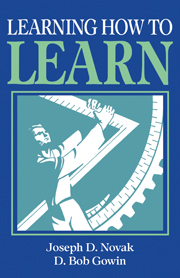Book contents
- Frontmatter
- Contents
- Foreword
- Preface
- Acknowledgments
- 1 Learning about learning
- 2 Concept mapping for meaningful learning
- 3 The Vee heuristic for understanding knowledge and knowledge production
- 4 New strategies for instructional planning
- 5 New strategies for evaluation: concept mapping
- 6 The use of the Vee for evaluation
- 7 The interview as an evaluation tool
- 8 Improving educational research
- Appendixes
- References
- Index
1 - Learning about learning
Published online by Cambridge University Press: 05 June 2012
- Frontmatter
- Contents
- Foreword
- Preface
- Acknowledgments
- 1 Learning about learning
- 2 Concept mapping for meaningful learning
- 3 The Vee heuristic for understanding knowledge and knowledge production
- 4 New strategies for instructional planning
- 5 New strategies for evaluation: concept mapping
- 6 The use of the Vee for evaluation
- 7 The interview as an evaluation tool
- 8 Improving educational research
- Appendixes
- References
- Index
Summary
WHAT IS THIS BOOK ALL ABOUT?
We are concerned with educating people and with helping people learn to educate themselves. We want to help people get better control over the meanings that shape their lives. Educating is powerfully liberating; failures in educating are powerfully oppressive. Wherever educating occurs, in schools and out, we think we can help people get better control over the events of educating, and thus over that part of their lives that is being transformed.
“Seek simplicity, but distrust it,” claimed Alfred North Whitehead. We share this view, and desire in seeking simplicity to preserve complexity. Sometimes simple ideas are so obvious they are obscure. We will try to illustrate simple but potentially powerful strategies to help students learn and to help educators organize learning material. The two principal educational tools we will discuss are concept mapping (see Figure 1.1), which is a way to help students and educators see the meanings of learning materials, and knowledge Vee diagramming (see Figure 1.2), which is a way to help students and educators penetrate the structure and meaning of the knowledge they seek to understand. In addition, we will describe some strategies that help students and teachers move toward what we will call shared meanings and feelings. This task is ambitious, but our experiences have shown that it is not unattainable. We invite you to join us in an exploration that is still very much in progress, for we (the authors) and our students are continuing our search for ways to become better teachers and/or learners and to help students learn what it means to learn.
- Type
- Chapter
- Information
- Learning How to Learn , pp. 1 - 14Publisher: Cambridge University PressPrint publication year: 1984
- 3
- Cited by



